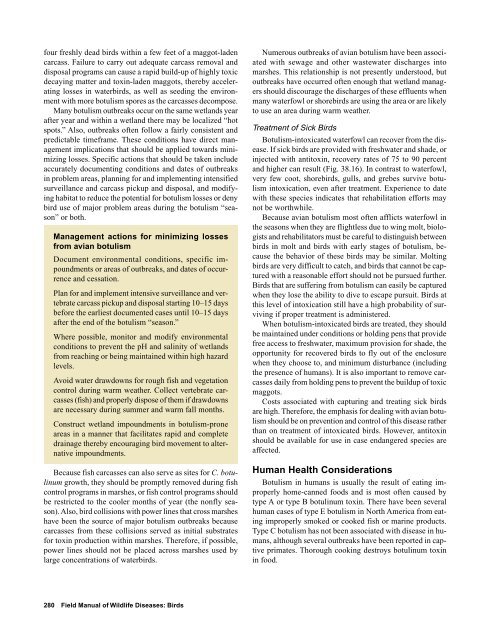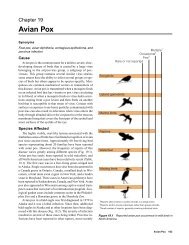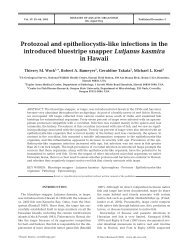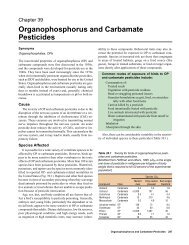Chapter 38 Avian Botulism - National Wildlife Health Center
Chapter 38 Avian Botulism - National Wildlife Health Center
Chapter 38 Avian Botulism - National Wildlife Health Center
Create successful ePaper yourself
Turn your PDF publications into a flip-book with our unique Google optimized e-Paper software.
four freshly dead birds within a few feet of a maggot-laden<br />
carcass. Failure to carry out adequate carcass removal and<br />
disposal programs can cause a rapid build-up of highly toxic<br />
decaying matter and toxin-laden maggots, thereby accelerating<br />
losses in waterbirds, as well as seeding the environment<br />
with more botulism spores as the carcasses decompose.<br />
Many botulism outbreaks occur on the same wetlands year<br />
after year and within a wetland there may be localized “hot<br />
spots.” Also, outbreaks often follow a fairly consistent and<br />
predictable timeframe. These conditions have direct management<br />
implications that should be applied towards minimizing<br />
losses. Specific actions that should be taken include<br />
accurately documenting conditions and dates of outbreaks<br />
in problem areas, planning for and implementing intensified<br />
surveillance and carcass pickup and disposal, and modifying<br />
habitat to reduce the potential for botulism losses or deny<br />
bird use of major problem areas during the botulism “season”<br />
or both.<br />
Management actions for minimizing losses<br />
from avian botulism<br />
Document environmental conditions, specific impoundments<br />
or areas of outbreaks, and dates of occurrence<br />
and cessation.<br />
Plan for and implement intensive surveillance and vertebrate<br />
carcass pickup and disposal starting 10–15 days<br />
before the earliest documented cases until 10–15 days<br />
after the end of the botulism “season.”<br />
Where possible, monitor and modify environmental<br />
conditions to prevent the pH and salinity of wetlands<br />
from reaching or being maintained within high hazard<br />
levels.<br />
Avoid water drawdowns for rough fish and vegetation<br />
control during warm weather. Collect vertebrate carcasses<br />
(fish) and properly dispose of them if drawdowns<br />
are necessary during summer and warm fall months.<br />
Construct wetland impoundments in botulism-prone<br />
areas in a manner that facilitates rapid and complete<br />
drainage thereby encouraging bird movement to alternative<br />
impoundments.<br />
Because fish carcasses can also serve as sites for C. botulinum<br />
growth, they should be promptly removed during fish<br />
control programs in marshes, or fish control programs should<br />
be restricted to the cooler months of year (the nonfly season).<br />
Also, bird collisions with power lines that cross marshes<br />
have been the source of major botulism outbreaks because<br />
carcasses from these collisions served as initial substrates<br />
for toxin production within marshes. Therefore, if possible,<br />
power lines should not be placed across marshes used by<br />
large concentrations of waterbirds.<br />
Numerous outbreaks of avian botulism have been associated<br />
with sewage and other wastewater discharges into<br />
marshes. This relationship is not presently understood, but<br />
outbreaks have occurred often enough that wetland managers<br />
should discourage the discharges of these effluents when<br />
many waterfowl or shorebirds are using the area or are likely<br />
to use an area during warm weather.<br />
Treatment of Sick Birds<br />
<strong>Botulism</strong>-intoxicated waterfowl can recover from the disease.<br />
If sick birds are provided with freshwater and shade, or<br />
injected with antitoxin, recovery rates of 75 to 90 percent<br />
and higher can result (Fig. <strong>38</strong>.16). In contrast to waterfowl,<br />
very few coot, shorebirds, gulls, and grebes survive botulism<br />
intoxication, even after treatment. Experience to date<br />
with these species indicates that rehabilitation efforts may<br />
not be worthwhile.<br />
Because avian botulism most often afflicts waterfowl in<br />
the seasons when they are flightless due to wing molt, biologists<br />
and rehabilitators must be careful to distinguish between<br />
birds in molt and birds with early stages of botulism, because<br />
the behavior of these birds may be similar. Molting<br />
birds are very difficult to catch, and birds that cannot be captured<br />
with a reasonable effort should not be pursued further.<br />
Birds that are suffering from botulism can easily be captured<br />
when they lose the ability to dive to escape pursuit. Birds at<br />
this level of intoxication still have a high probability of surviving<br />
if proper treatment is administered.<br />
When botulism-intoxicated birds are treated, they should<br />
be maintained under conditions or holding pens that provide<br />
free access to freshwater, maximum provision for shade, the<br />
opportunity for recovered birds to fly out of the enclosure<br />
when they choose to, and minimum disturbance (including<br />
the presence of humans). It is also important to remove carcasses<br />
daily from holding pens to prevent the buildup of toxic<br />
maggots.<br />
Costs associated with capturing and treating sick birds<br />
are high. Therefore, the emphasis for dealing with avian botulism<br />
should be on prevention and control of this disease rather<br />
than on treatment of intoxicated birds. However, antitoxin<br />
should be available for use in case endangered species are<br />
affected.<br />
Human <strong>Health</strong> Considerations<br />
<strong>Botulism</strong> in humans is usually the result of eating improperly<br />
home-canned foods and is most often caused by<br />
type A or type B botulinum toxin. There have been several<br />
human cases of type E botulism in North America from eating<br />
improperly smoked or cooked fish or marine products.<br />
Type C botulism has not been associated with disease in humans,<br />
although several outbreaks have been reported in captive<br />
primates. Thorough cooking destroys botulinum toxin<br />
in food.<br />
280 Field Manual of <strong>Wildlife</strong> Diseases: Birds
















